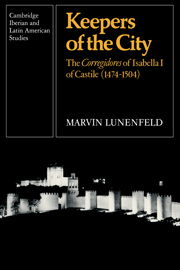Book contents
- Frontmatter
- Contents
- List of tables
- Glossary
- Map: Distribution of royal jurisdictions (1474–1504)
- 1 The omnicompetent servant
- 2 Establishing authority
- 3 The naked sword (1474–85)
- 4 Faithful servants (1485–94)
- 5 Careers open to talent: judicature, remuneration, residencia
- 6 Lords and prelates: a matter of privilege
- 7 The end of convivencia: Jews, Christians, and Muslims
- 8 Difficult governance (1495–1504)
- 9 The queen in heaven: troubled aftermath
- Notes
- Select bibliography
- Index
1 - The omnicompetent servant
Published online by Cambridge University Press: 05 November 2011
- Frontmatter
- Contents
- List of tables
- Glossary
- Map: Distribution of royal jurisdictions (1474–1504)
- 1 The omnicompetent servant
- 2 Establishing authority
- 3 The naked sword (1474–85)
- 4 Faithful servants (1485–94)
- 5 Careers open to talent: judicature, remuneration, residencia
- 6 Lords and prelates: a matter of privilege
- 7 The end of convivencia: Jews, Christians, and Muslims
- 8 Difficult governance (1495–1504)
- 9 The queen in heaven: troubled aftermath
- Notes
- Select bibliography
- Index
Summary
The facade of the city hall at Valladolid informs all who examine its portals that here is the House of the Corregidor. Isabella the Catholic was the first to make successful general use of this official to gain a new measure of authority over all areas in the royal domain previously under merely nominal jurisdiction. The august personage of the corregidor provided the enduring link between the municipality and the central government in whose name he ruled. Corregidores, and asistentes (assistants) or gobernadores (governors) – alternatively titled office-holders with equivalent powers and duties – were everywhere put in place to attempt to oversee many aspects of the day-to-day operations of provinces, cities with their outlying areas, towns, and hamlets. They made sure the ramparts were secure, the streets cleaned, and the market-place policed. By virtue of special judicial powers they presided over cases both civil and criminal, ranging from inheritance disputes to murder, adultery, and blasphemy. When necessary, they mustered urban militias and sometimes led them into battle. All in all, this was a full agenda for any bureaucrat.
Max Weber regarded functionaries of the monarchies of this era as key figures in the transition from decentralized feudal, or patrimonial, society to the “rationalist” centralized bureaucracy that characterizes both the modern state and contemporary business organizations. Despite their importance to the Castilian crown, the group of individuals who held the post of corregidor under Isabella I have been examined inadequately.
- Type
- Chapter
- Information
- Keepers of the CityThe Corregidores of Isabella I of Castile (1474-1504), pp. 1 - 9Publisher: Cambridge University PressPrint publication year: 1987



